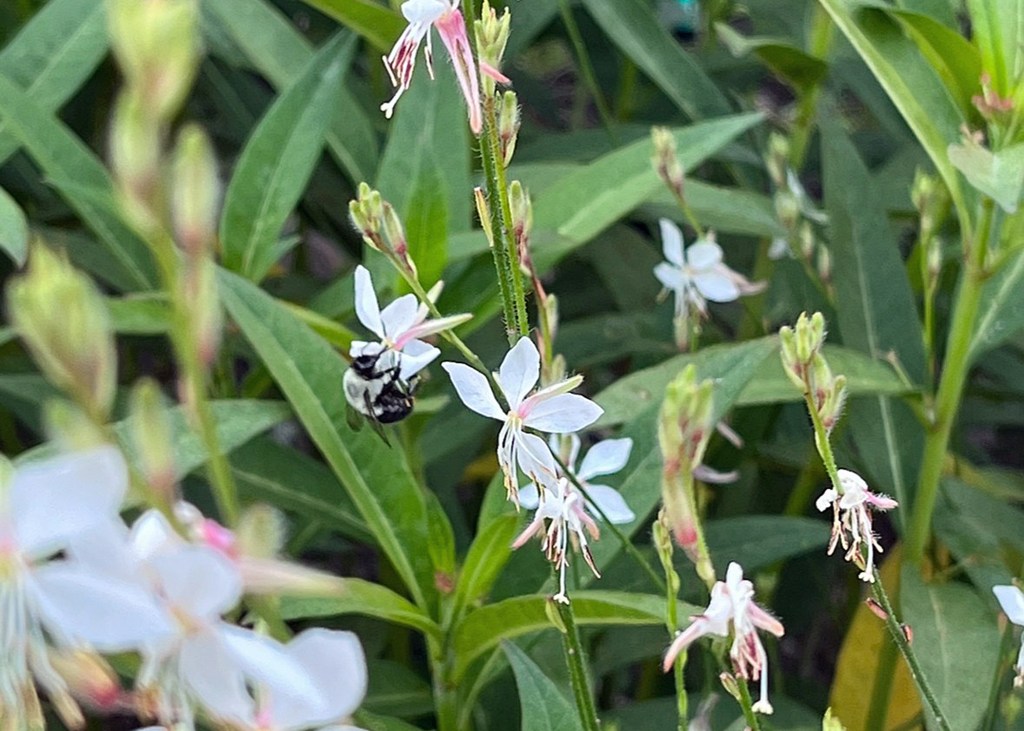Volunteer plants add surprises to gardens
Published 10:47 pm Monday, July 1, 2024

- Gaura are graceful plants with airy sprays of delicate white and pink flowers and a knack for popping up in unexpected places. (Photo by MSU Extension/Eddie Smith) Alt text -- A bee hangs onto a slender stem that has white flowers.
By Eddie Smith
MSU Extension Service
One of my favorite gardening experiences is seeing plants spontaneously appear in various spots in my home garden and landscape.
I love these plant volunteers, and I let them flourish in unexpected places around my garden. Their surprise appearances make the garden feel alive and ever-changing.
Trending
I once wrote about a vinca whose tiny volunteer seedlings emerged from a crack in my greenhouse floor, sprouting from seeds left by last year’s plants. These little surprises, with their vibrant red and pink blooms, made quite an impression with their tenacious growth and cheerful flowering.
I often find vincas growing in crevices and along pathways, their bright flowers adding a pop of color to the otherwise dull spaces. Their ability to thrive in less-than-ideal conditions makes them a welcome addition, and I look forward to seeing where they will appear next.
Another volunteer plant that brings joy to my garden is coleus.
Known for their striking, colorful foliage, coleus plants have a way of appearing in unexpected places, adding vibrant splashes of red, purple, green and yellow to the landscape. Their large, velvety leaves come in a variety of patterns, from bold stripes to delicate veining, making each coleus unique.
I enjoy their surprise appearance, as their bold hues and intricate leaf designs enhance my garden’s overall aesthetic. They transform ordinary corners into stunning displays of natural art.
One of the most delightful volunteer plants in my garden is the gaura.
Trending
These graceful plants have airy sprays of delicate white and pink flowers and a knack for popping up in the most unexpected places. Their slender stems and butterfly-like blooms add a whimsical touch to the landscape.
I often find gaura nestled among other plants or even in the cracks of walkways. Their delicate beauty adds elegance and movement to the garden, as their flowers sway gently in the breeze.
During a recent scouting trip for Southern Gardening, I spotted some begonias growing out of cracks in a concrete and brick stairway. The previous year, begonias grew in a container on the stairway, and the seeds fell into cracks in the bricks and concrete.
These begonias, with their vibrant green leaves and bright white flowers, turned an ordinary stairway into a miniature garden oasis, demonstrating the resilience and beauty of nature.
What’s fascinating about all of these flowering volunteers is that they often differ from their parent plants. This is because most flowering annuals from garden centers are hybrids, bred for specific colors, growth habits and other traits.
When hybrid plants are pollinated, it’s like rolling genetic dice. The result is seedlings that frequently display a variety of traits, reflecting the genetic diversity of their breeding history. This genetic variation makes each volunteer plant unique.
Watching these volunteers develop and reveal their distinct characteristics is like uncovering a hidden treasure, each one an extraordinary masterpiece.
One important thing to know about volunteer plants is that they primarily spread via seeds.
I always allow a portion of the flowering plants in my garden to go to seed. I collect and scatter these seeds or simply let nature and the wind distribute them. This natural propagation method ensures a continuous supply of delightful surprises throughout the garden.





